The world is now our oysters
Each oyster filters over 220 liters of sea-water a day. Imagine how much our ocean has been polluted – billions of tons yearly which includes 8 million tons (95%) of plastics and non-filtered fibers. The humble oysters can clear liquid pollutants but residues remain as giant gyres of rubbish deep in our ocean. Many marine mammals, including edible fish consume micro-plastics and many were threatened with breathing obstructions. It is predicted that there’ll be more micro-plastics than fish in the oceans by 2050. Even as the world needs oysters to filter our oceans it is anathema why so many oyster farms are producing oysters solely for human consumption. The good oysters that remove pollutants are precisely non-edible or non-marketable and one wonders if premium oysters must be grown in clean water to meet human pleasures the oceans would be losing a great friend. But good news – the other 85 000 species of mollusks also feed by filtering seawater. We meet two of them in this story – about the pearl of adversity. Call them Left and Right. Why? The reason can be seen from the top of the shell and watching the direction of spiral, you can see the left uses a left-hand spiral (sinistral) as opposed to the right shell (dextral).
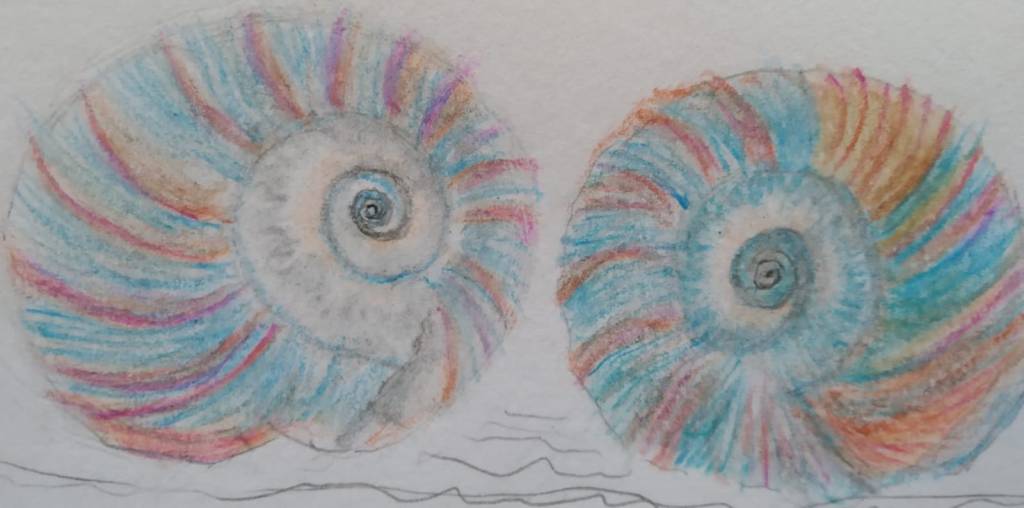
Why is it different is now being explained genetically by scientists. Whereas originally it was thought that chiral molecular malformations caused this it became unlikely because amino acids and biomolecules are left-spiral in structure. Using the CRISPR genetic editor it has been shown that the rare lefty spirals are caused by a malformed gene. And what happened to Lefty and Righty as they languished off the Hawaiian coast of Oahu had a lot to do with this gene. Molluscs eat by filtering plant matter and lots of plankton from seawater. Hundreds of liters provide them with daily sustenance but their digestive systems would rather have less irritants such as sand, gravel or hard bony structures. Lefty tend to have more solids to filter than his counterpart. A look at the tidal movement explains this – the counter clockwise water swirls favor washing particulates into Lefty’s guts than Righty’s. Throughout Lefty’s lifespan his guts have to protect itself from the sharp edges of particulates. So Lefty spits out more and whatever he fails to dislodge his guts secrete a coating to protect against sharp edges. Righty however gets more through his system making him plumb and juicy. Envious though Lefty is he doesn’t complain but Righty cannot get enough of the ocean floor, often propelling himself upstream to catch more zooplanktons. Hey wait up!, Lefty would shout out, and often choke on the spits as he does. But Righty thinks only of himself. “Lazy weakling”, Righty would mutter under his breath as he chases a bloom of planktons. This went on for two summers and Righty became overgrown and bloated that he couldn’t chase the currents of plankton blooms. Lefty however was content to sit next to his friend to eat whatever he could extract from the sand and mud. But these are the moments that he wishes he doesn’t have to endure the constant irritations of life. Lefty was about to find out that he’s the luckier mollusk. Turns out that among the reefs lie several molluscivore – marine mammals such as walrus, seals, parrot or puffer fish that hunts shellfish. Even the octopus has a sharp awl that it uses to drill into succulent bivalves. So that bright sunny day a walrus caught sight of fatty Righty. It handily came by and took him between its flippers.

Like an ice-cream cone it sucked Righty out of its shell and vanished as quickly, leaving Righty’s empty house to sink down to the ocean floor. Lefty shuddered as his friend’s shell landed askew next to him followed by a rush of sand-stream and bubbles. Choking and spitting out the uprush of silt, Lefty wondered what he should do now, being alone. “You can stay by me…I’ll be your protector from now.” – a raspy voice rang out. Lefty looked at the direction of the voice and sees a conch shell, no larger than himself, half-buried in the sand. The voice continued, “No human, walrus or fish would dare come by me as my harpoon carries enough poison to kill ten humans!” Lefty looked at the conch – it seemed like the most harmless, plain shell around but its reputation is infamous.
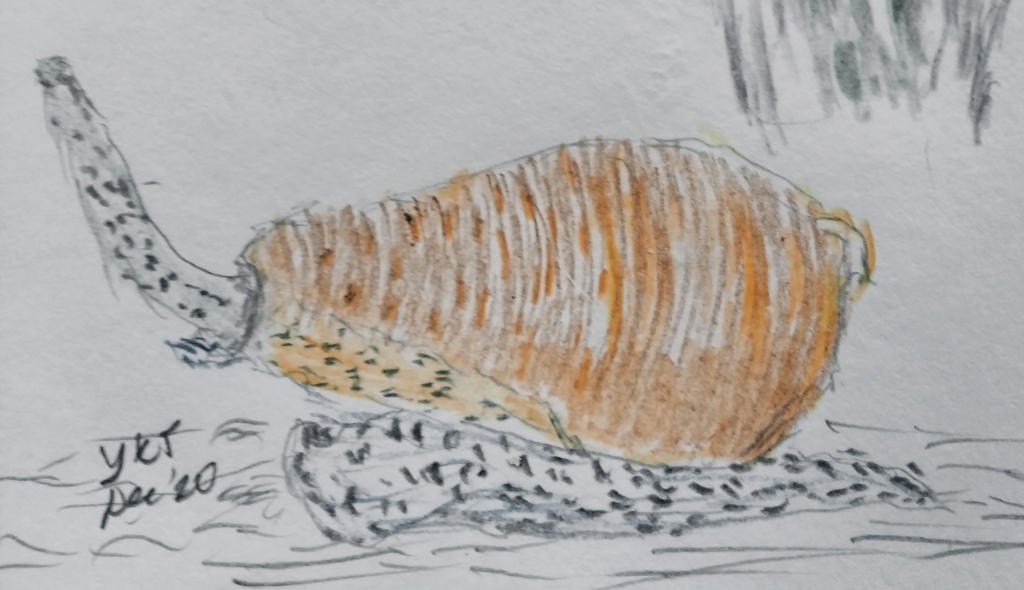
And so Lefty sally forth each day, content to be next to Dreadnought the conch assassin. Until the day of the hurricane. The undercurrents were very swift and by the next day when the waves had calmed, Lefty found himself on the pristine beach. He was not alone. Next to him lying on the sparkling sand were other shells swept from somewhere. Then when he was enjoying the warm sunshine all of a sudden a hand reached down and picked him up. “Hey, look!” – the person exclaimed. “Aren’t those supposed to be extinct?” Lefty wasn’t sure what was that all about. Until he saw the other shells on the sand.

The Hawaiian tree snail was supposed to be extinct. The researchers excitedly collected them with Lefty and returned to their lab. But when they examined Lefty there was another pleasant surprise. They found several pearls within his body. Those were the fruit of months Lefty had to endure the hardship for being a lefty. Difficulties in his life had brought along pearls of great price.
Animal love
It’s been well documented that animals respond to human love. It comes mainly through touch and caresses. Unlike eye-contact, which can lead to aggression, humans and animals have learned to communicate by touch and sound throughout history. Though lacking in human vocalizations, animals confirm their needs with actions.

Tiffany, even at age 14 shows her love for all the animals in her father’s farm. If she’s able to get up early enough she’ll milk the cows and pats them with affection. Then before leaving for school she’ll take out the hay for the mares and donkeys. Obviously she caresses each one and talks to them. She can tell you how the pigeons coot in appreciation as she calls out to them for their feed. From young she knew her destiny was to be an animal trainer and her chance came after graduating from veterinary school. She was invited to Thailand on an exchange WWF program regarding the welfare of elephants. Coming from a country where elephants are not endemic, to Thailand filled her with excitement. Especially when she’s introduced to the calves and babies. And there’s something about elephants which she had no experience on.

Tiffany met orphan baby Behu when he was brought into the elephant sanctuary. At such a young age, baby elephants need the herd to develop security and Behu was moving around to see if which female would adopt him. In the end Tiffany became closest to him. When Behu became stronger it was decided that he should work with the other elephants. These days they are not made to labor hauling logs but entertaining tourists at the camp. Tearfully Tiffany said goodbye as Behu was given to its handler, a mahout who promised her to take good care of Behu. Years passed.
Tiffany became the busy chief vet at the sanctuary, treating all wildlife besides pachyderms. She is also much fascinated by the variety of South-East Asian birds and her favorite pastime is to trek into the jungle, field glasses in hand with her bird manual. One day as she was peering through at a bulbul a trumpeting call rang out. A bull elephant broke out of the jungle, waving its huge ears threateningly. Tiffany had learned not to panic or run but wait patiently for the beasts to retreat, meaning no harm. But then a strange thing happened. The bull lifted its trunk again and again as if sniffing the air and bowed its head repeatedly. Tiffany couldn’t figure it out but the elephant remembers! For ten years Behu had served the sanctuary and was later released to the wild to start his own family. After Behu came near and caressed Tiffany with its bristled, tawny trunk that she realized it was Behu. What a tearful reunion! And the strange thing was that the rest of the herd was wild – some had never had encounters with humans before. Elephants seem to know who their allies are. Tiffany went right to work, examining Behu and his harem as well as little ones. She took notes and photos where wounds needed to be treated. When she waved goodbye to the herd she was determined that she had an unfinished business with Behu’s ex-mahout. It was to become another adventure in the jungle.
She got hold of the mahout along with the help of four others to track and treat Behu and his herd. After several hours searching in her jeep followed by hours getting to the elephants and treating them in the jungle she took them home. The drive was long – through several villages where the men live. After sending the last one home she was crossing a river when a storm came. As she was coming to the end of the flimsy bridge a river swell moved the bridge from its moors, overflowing her jeep. She struggled out of the vehicle and stumbled to the other side, but her vehicle remained stuck at the wooden bridge. How to get back to civilization? You’d have thought that an easy end to this story is where Behu and his giants will come pull Tiffany to safety with her vehicle. But this is not what turned out. She waited for a while trying to search a signal to her hand-phone without avail. Then she realized that the compass still worked, even without a WiFi signal – go figure how this was possible. With darkness descending and saving a map from her vehicle she decided that trekking to the nearest village was her best chance. After an hour in the jungle tracks she was almost engulfed by darkness – and near desperation as her torchlight battery began to wane. If only Behu were there! But nothing. Besides tigers, leopards and other wildlife abound in the jungle. She sat down on a branch to rest, praying help to come and slapping at mosquitoes. Then she saw the trunk through the moonlight, partly hidden by the trees. She almost cried. Then she thought – there’re many wild elephants in Thailand – how could this be her friend? She tried calling his name. Then a trumpet call followed. Behu slowly appeared in the opening, waving his trunk as usual. She hugged him, the muddy smell regardless. “Behu – you’ve got to get me to a village – anywhere with humans!” – and even before she finished speaking Behu’s powerful trunk lifted her to his sprawling back. Slowly the herd trundled through pitch-dark jungle – Tiffany had never ridden saddle-less on an elephant before. Still she sat pat because the tall grass below her hides pythons or other dreadful creatures. Then after a while the herd stopped and Behu refused to go further. Why? As Tiffany peered through the elephant grass she saw lights. The herd would not go nearer to civilization – they have been warned by the villages protecting their crops. With a parting hug, Tiffany trudged fearfully towards the light but the herd stood still watching. Then it hit her. Behu and his family had been following her silently all the way from the river, out of sight. The gentle giants had learn to avoid humans at all possible until she called his name.
After returning to a safe home and fully rested Tiffany thanked her friendly villagers and days later got another convoy to retrieve her jeep and to repair the bridge. As she drove home that day she glanced at the jungle thoughtfully. She knew that her friends are there somewhere whenever they can catch her scent. Then she thought for a moment she could hear the faint shrill of Behu’s trumpet call.
The never-ending tail
There’re over 6000 species of lizards. The squamate family includes chameleons, skinks, iguanas, flying dracos, monitor lizards, anoles, geckos (house lizards) and the komodo dragon. Not all are able to drop their tails to escape predators and at least one – the crested gecko does not regrow them. Many are carnivorous and the Gila monster is a venomous specie. Most are quadrupedal but legless lizards are not snakes. Some have an extra third (parietal or pineal) eye atop their skulls to detect light and predators. And also amazing suction leg-pads.

But they are low in the predatory chain – hawks, snakes, cats, wolves, spiders and other lizards eat them and so escapades must be a skill for survivors. Our story of the never-ending animal tail begins over 150 million years ago – in the late Jurrasic period. A Stegosaurus (herbivorous thyreophoran) had been watching its eggs. They may be thought as the ancestors of lizards but this is disputed as the squamates are thought to have evolved even earlier from the Triassic epoch or even the Permian period. Its spiky tail and spinal flaps makes it distinctive. But a T-rex had already stumbled upon the doting mother as potential lunch. Flight for the stegosaurus was not an option even though the T-rex had already established itself as the top carnivore.
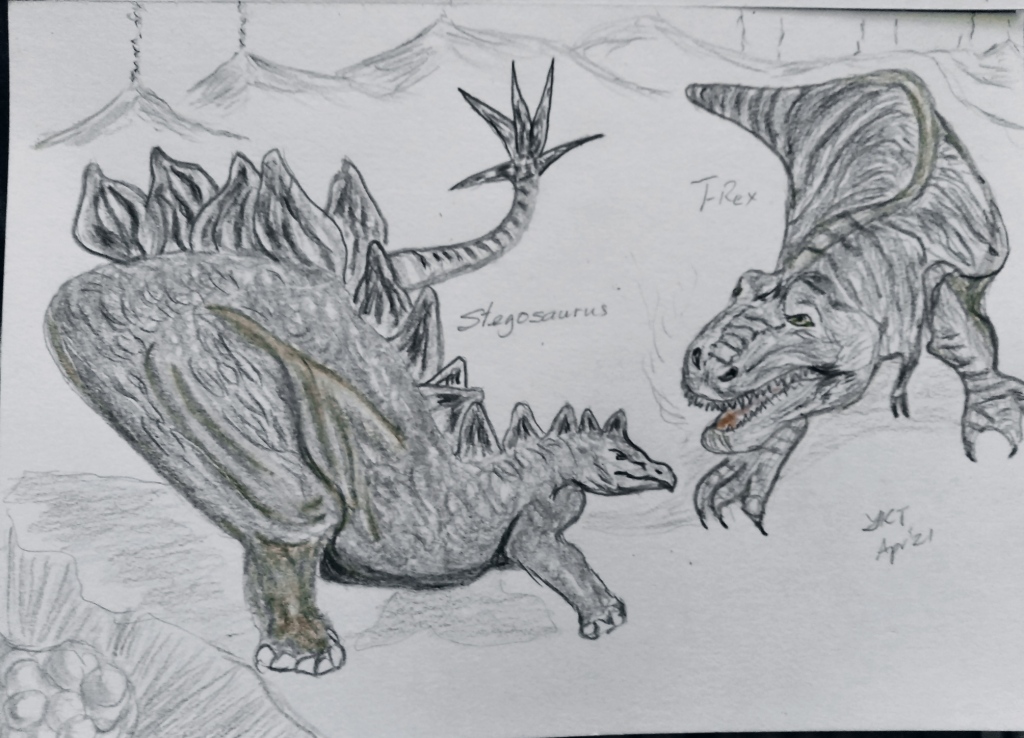
The Stego was wily. It selected its nest next to a steep cliff. Though lacking a killing jaw like the Rex it had two non-deformed forelegs and of course the formidable spiked tail. The T-rex went for the jugular with its sharp teeth and its enormous crushing jaw would do quick work for the kill. But Stego was also quick to deflect and it had its scaly defenses. So the T-rex struck again – this time on Stego’s back. The hideous jaws took hold and the tremendous neck muscles started to fling the lighter Stego around. Stego had one last weapon and so it flung its spikes crashing on the T-rex belly. The T-rex had a brief shock, but its tough belly-armor resisted the strike. It regripped the Stego on its back to paralyze it. While doing so it had to move towards the cliff’s edge for a better posture. Stego’s tail was then trapped temporarily under the T-rex belly, immobilized. The T-rex went for the final thrust by twisting its head. It was to be his undoing. It suddenly released Stego’s tail, allowing it to fling out of the way back for a backlash. With a mighty fling the tail went full circle, crashing it, of all places onto the rear leg of the T-Rex. Two of the spikes lodged on the leg. The force was enough to tip the T-rex over the cliff. Stego lay still for a moment as the weight of the falling mass dragged it over to the cliff’s edge, its tail spikes still imbedded in the T-rex rear leg. For a moment it looked like Stego was also about to tip over down the deep canyon. T-Rex instinctively flexed its torso in a bid to clamber back on the cliff. Then the tail spikes came off its leg. It fell. Because of the depth of fall only a faint thud was what could be heard from where Stego remained. Stego moved slowly to check on her eggs. As she looked over each one, she was sure that some had stopped trembling and feeling warmer. “Hurry up – get out of your shell and grow quickly. Today its the Rex, tomorrow it may be a raptor.”
Soje was a draco – a specie of gliding lizard with flaps between their jaws and legs. He had overcame his fear of heights and learned to glide from predators. Now fully grown and used to taking care of himself, Soje does not just stay up in his tree-hole but is hunting insects even on the ground. In fact he’s been staying on the ground more often these days because of the abundance of food near the water than on the tree. But a lesson of life awaits him. One day while picking up a colony of ants at the base of a tree with his spit something else was watching him. Hidden behind the trunk was a monitor lizard. It appeared hungry and even a lizard would do for a meal. Soje momentarily heard a rush of wind when the monitor lizard came at him. As he turned to run away it occurred to him using his parietal eye that he might not be able to get away fast enough. He turned to jump and glide away as usual – but he was at ground level! So he waddled away as fast as he could on all fours. The monitor lizard spit shot out. Missed! The second time he was bound to strike Soje. But instinctively something electric went through Soje’s body – all of a sudden he felt lighter and faster. The monitor lizard’s spit hit something wriggling on the ground behind Soje. Distracted by the appendage, the monitor lizard stopped while Soje scuttled away into a rock crevice. The act of self-severing their tails to escape predation is called autotomy where the lizard’s muscles auto-contract, so that the weakest point in their tail structure fails. Soje knew that he was safe and returned to his tree-hole. Not two weeks later a new tail emerged from his stump. He was ready again to descend to the happy hunting ground. Will his luck hold?
Again he was at the river-bank feeding all the ants that gathered there for water. Then without warning a plover burst through the reeds towards him. They normally eat insects but it seems this time it wanted something bigger. Soje turned and ran. But the plover doesn’t have to run to catch him. It could fly faster. Before long it was right over Soje descending quickly to peck at him. Panic stations again! Again he felt a weight dropped from his rear as he quickly entered a hole. His wriggling tail had saved him again. The plover picked it up with its sharp beak, still wriggling as it swallowed it whole. Soje could even be smiling at himself saying, “well that was worth losing for all the fat ants I picked at the river-bed.” But before Soje could exit the hole back to his tree something moved inside the dark hole. Turning round he came face-to-face with a green snake! Run! Soje knew exactly what to do. As he raced across the sand the green snake slithered ahead of him. Cornered Soje turned around to run the other way at the same time he was in panic again. Drop tail drop!! But now he had no more tail. The snake caught Soje tail-less, swiftly between its jaws. For snakes, a lizard is like a dessert creme de la creme. For Soje the never-ending tale ended there. He had not just ran out of luck, but out of a spare tail as well.
Memories of a thousand birdsongs
Why do birds sing? The obvious, common answer is territorial claim and to show off. But do the ladies sing? The conventional thinking is males show off to mate but females build nests. Recent observations reveal both sexes sing according to various seasonal and geographical needs. Some females do sing to attract males and others also sing to protect their nestlings. Actually it has been claimed (2016) that of about 660 songbird species two-thirds are singing females! But there could be something more primeval about singing – perhaps similar to the human’s need to live expressively. And what more joy than to hear the cacophony of birds alive in the morning!

The most colorful bird of N America calls to their pale greenish mates but screams aggressively at competing males. Hear their thin soothing sounds as they welcome Spring. Reminds me of a down-to-earth, practical friend, quick to defend but willingly fades into the background.

The blue jay announces its presence with sharp intermittent calls but with their mates becomes a soft rolling chatter. They also mimic calls of hawks, probably to warn their mate. Other repertoires of blue jay calls are “squeaky gate”, “pump handle calls”, “bell-jingle” and “rattle” calls, while jerking (head-bopping) their bodies up and down or fluttering their wings in expression. Their calls are versatile, modifying under different circumstances. A sensitive fellow always asserting his presence.
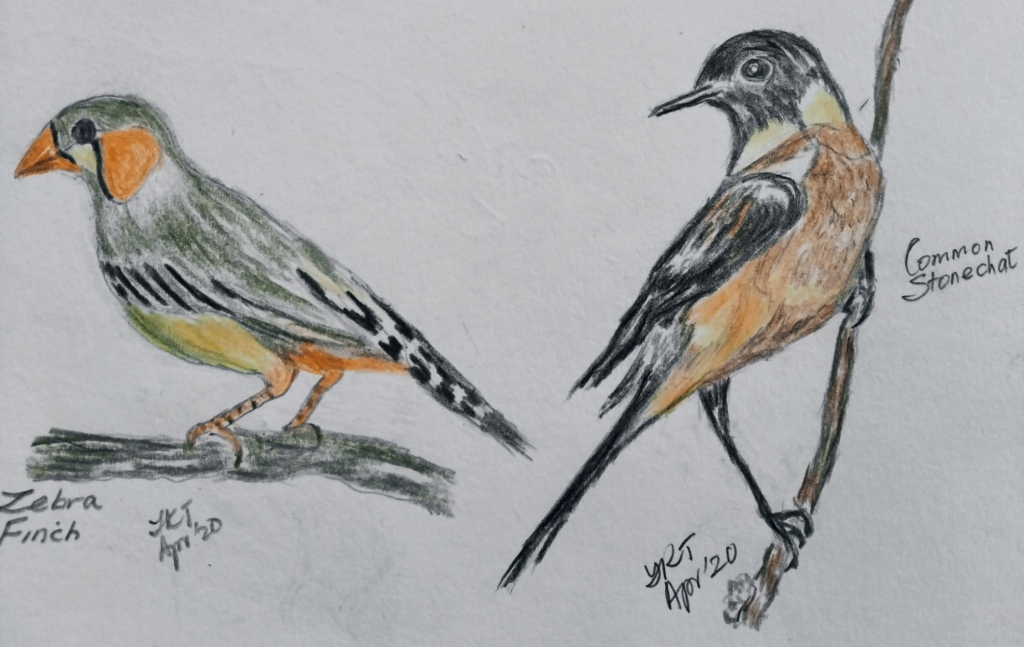
The finches calls are rapid cheery warbles or a chirpy song calling to their mates or just announcing their presence. The stonechats chirps in a similar way but intermingle with soft intermittent tweets. They remind me of active children – full of joy in play, even loud but willing to quieten down to conversation.
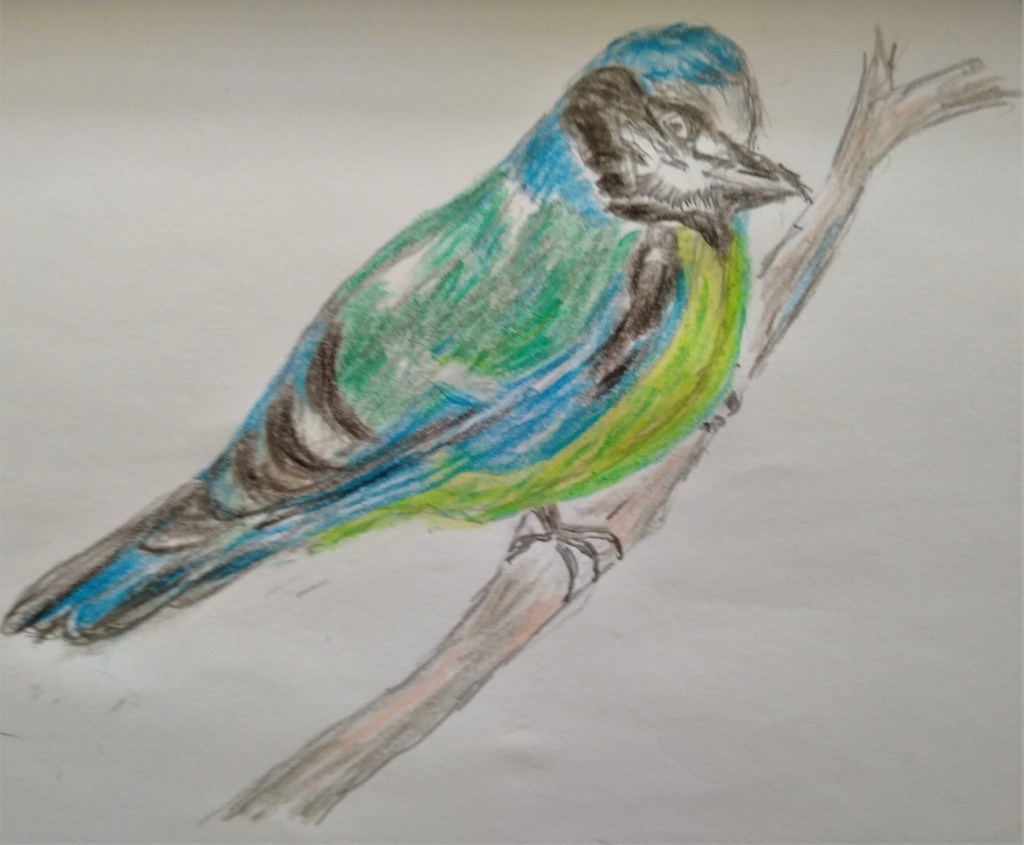
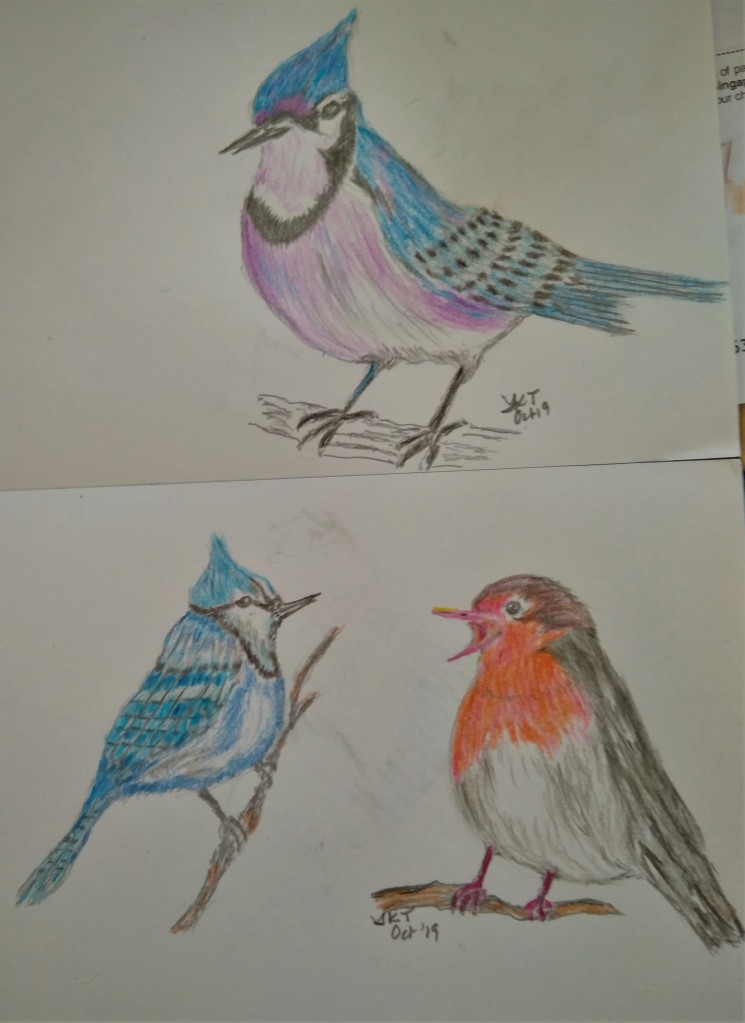
The robin (UK) is sensitive and quiet – responding to calls only they know. Understandably so because of their size and vulnerability to predator birds.
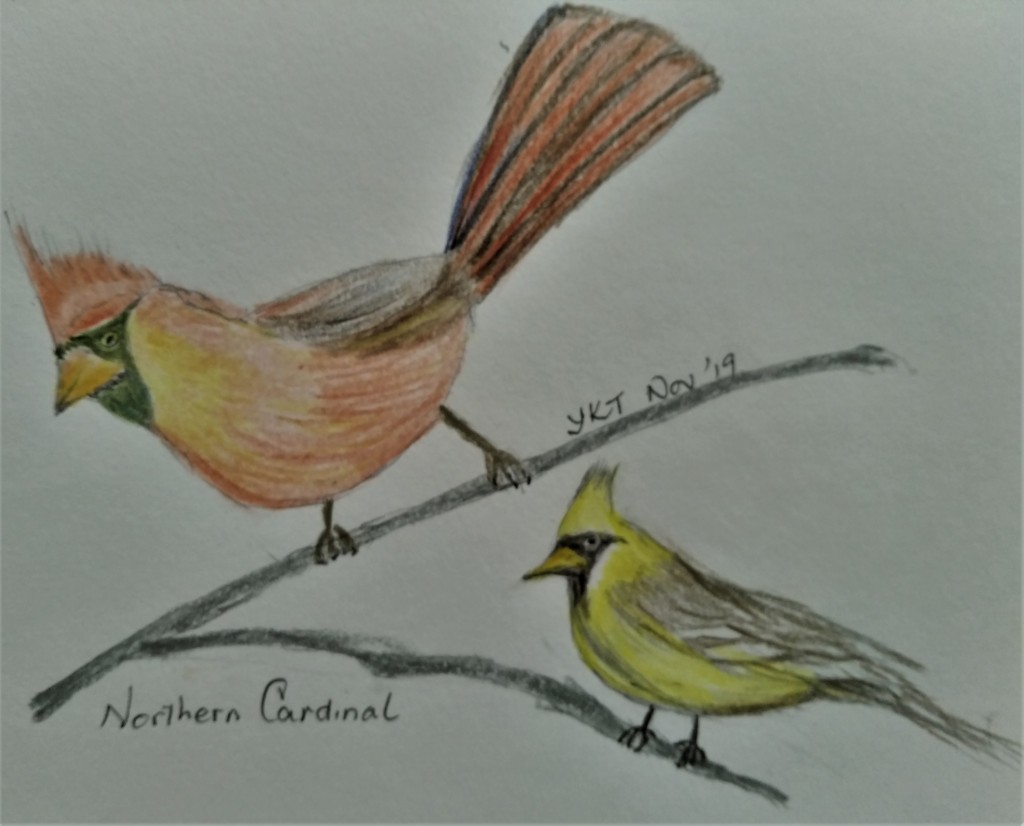
The Northern cardinals (mostly flaming red feathers) have clear, single resonating calls (4 or 5 times) with a responding ratchet-like call, equally gentle, followed by clicks. Some people you’ve met can always be sensed when they enter a room, which the cardinals reminds me of.
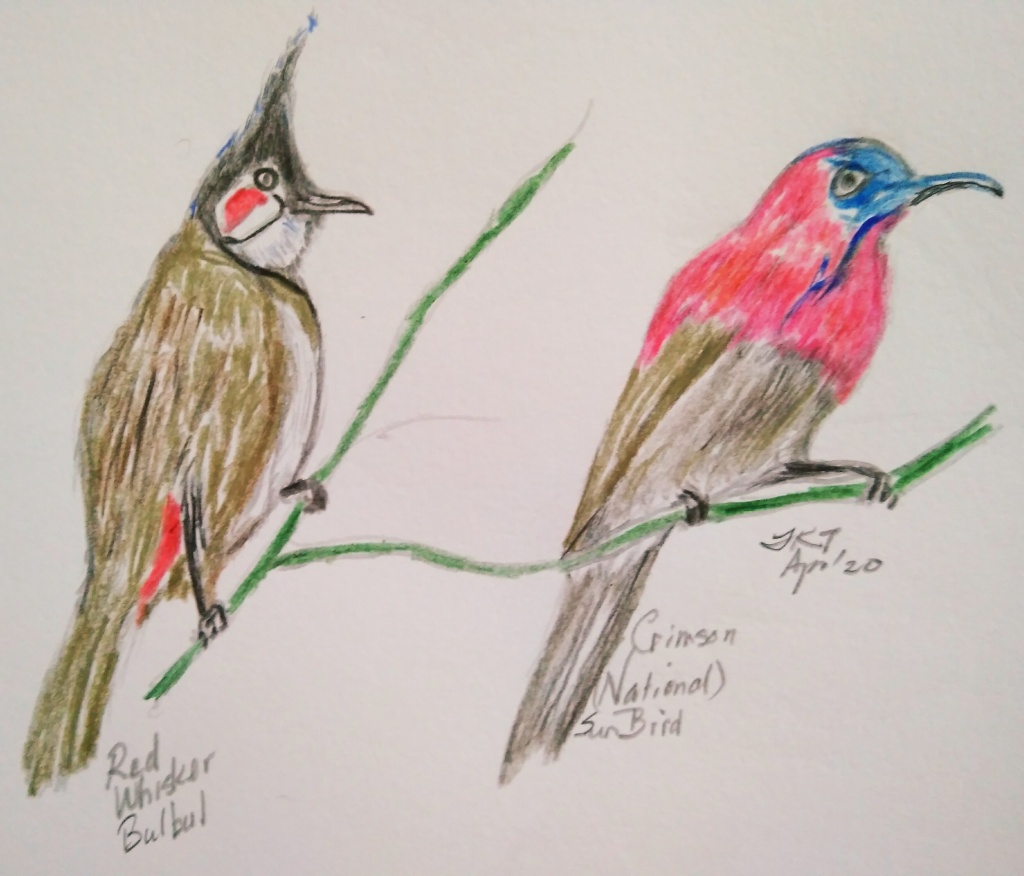
A high-pitch followed by a short glottal chirp, the red whisker bulbul enhances its color with its sound. A plain sparrow would call it unfair that some birds have it all! The flaming red (male) sunbird calls in a tinny whisper then interspersed with a stuttered roll. The girls would’ve been alerted if not already by his sartorial dash.
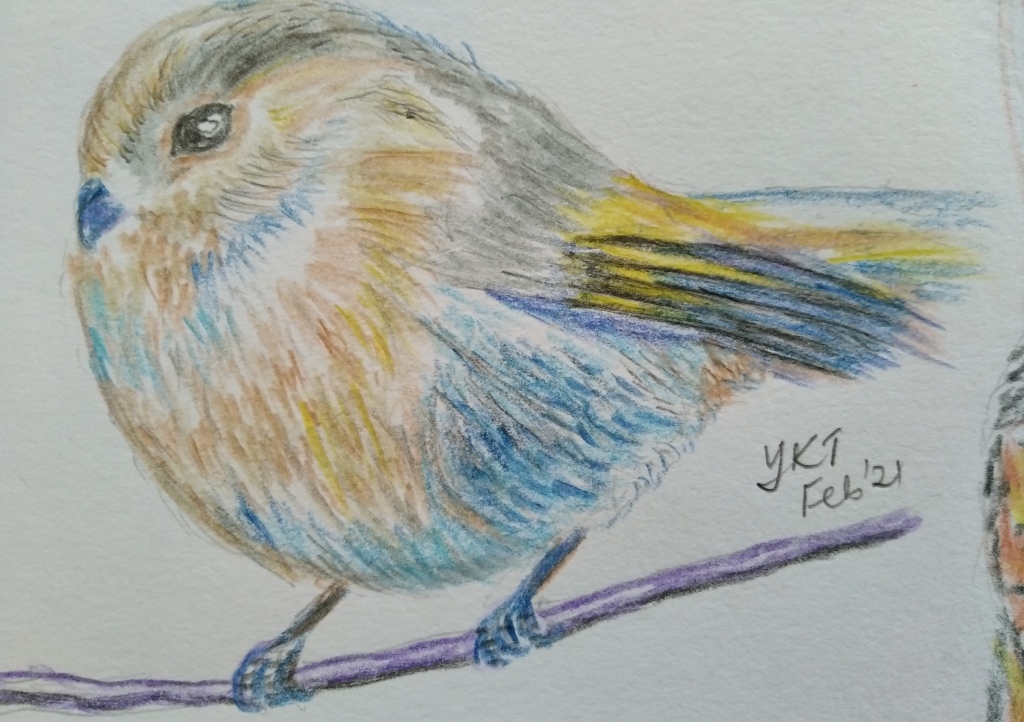
The European robin’s fluffy feathers conserves its body heat but gives some away with its shrill, squeaky trills – like saying “There’s life despite the cold!!”

They sing in phrases – with rising and falling tones. Birds have different vocalizations – the territorial calls, mating invite, alarms and just love-chats. Just like some humans!
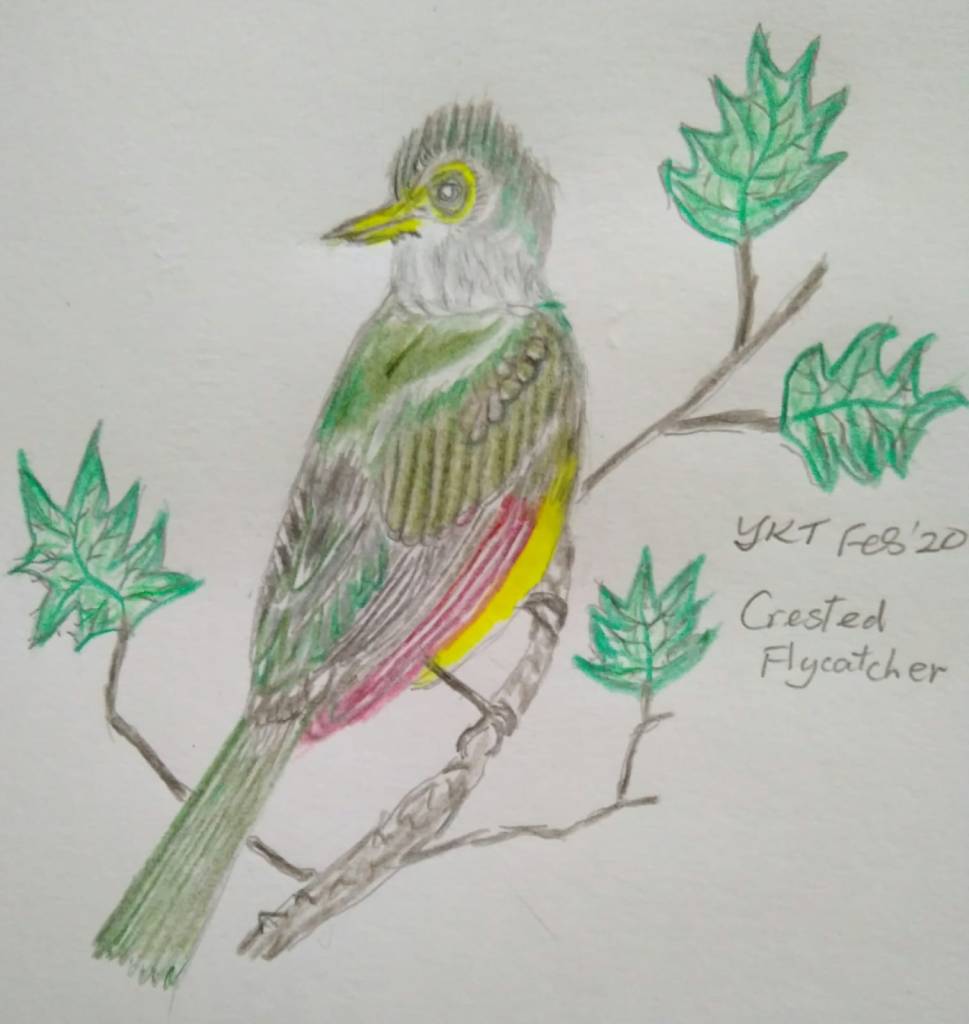
The great crested male flycatcher gives a single clear call, repeated, perhaps to tell his mate where he is? She’s though the busy one and he’s just happy to be around the practical wife. Just like some husbands?
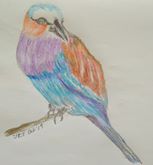

The dove is a melancholic singer. Some mourning-like coots can pull strings of grief from your heart – if there’s some grief left. Happy songs are often cheerful but sad, poignant bird-calls will greatly lift one’s spirits. Enjoy them while they’re around your garden or vicinity because their lifespan is often shorter than yours. One morning you may find them disappear from their usual perch, along with the magic of their sounds.
Saving the Arabian oryx
With the plethora of 72 antelope species (bovidae) in Africa one would have expected not to see them disappear so quickly. But recently (last 3000 years) a handful had disappeared. Because they are mostly herbivore lower in the food chain, if they reproduce fast enough they would easily survive predation. But atlas, their numbers cannot be sustained with habitat loss, especially for the larger species requiring bigger grazing space. Examples of those bigger than the Thomson gazelle are the kudu, eland, hartebeest the generuk and the gemsbok. Before 1986 the Arabian oryx (gemsbok is the SA species) could only be seen in captivity and it was after serious efforts to breed them in the wild did their numbers returned. This is their story.

My name is Abada, and I was born in early 1970s. At that time we travelled in large flocks all over the middle east, as far as north Syria and as east as Israel. We were well admired as the only white antelope in the world although we have a clear dark spot on the forehead and black fur legs. Sadly my parents were caught by a group of robbers when I was weaned. They were poor Bedouins intending to sell my parents to rich families who keep exotic pets. Many in my tribe were lost – some of starvation, others shot when they tried to escape. Others were slaughtered for game meat and had our horns stripped, believing they give magical or mystical powers. It had been so for decades, until my tribe and many others in the Middle East were reduced to extinction. I was considered cute and kept by a rich Bedouin. You might say that I was the among the last oryx in the Arabian peninsula to survive the pillage of the seventies. Then in early 1980s word got around that fewer tourists visited the Kingdom because of the lost of wildlife due to poachers. The sultan of Oman took notice and started a project to protect my species. About 400 of us were brought together to the Arabian Oryx Sanctuary. I was one of them, having been rescued to be reintroduced for reproduction in the wild. But soon poachers were there again – I recognized one of them who caught my parents. Meanwhile we were also the target of predators like cheetahs and lionesses. Once a poacher had to shoot a lioness taking down my brother. They even took away the corpse. We lost 200 of us, and the Sultan of Oman again started the project, this time with the Saudi Wildlife Authority to deter poachers and establish numerous release points into the wild. Among them were my grandchildren and great grand children.
But the war against the greed of poaching never ends. Antelopes roam over a large area of wastelands and forested hills. Poachers would track them and hide out over a vast area. So one day the rangers got together a plan – trapping poachers. They chose a few strong oryx among us and disguised a small network-camera hidden among our black foreheads, small enough to not be detected at first glance. With info-tech (IT) and GPS network tracking the rangers were able to set up an alarm system to alert rangers in any poaching activity. I had the finest of horns and deemed to be healthy enough to be targeted. So I was one of the camera carriers.
Many weeks passed without incidents. Twice the rangers had to track me down to ensure that my transmitter-camera had enough battery signal. Then one rainy spring day several of the doe who mated with me gave birth to fawns. It was a most vulnerable time when out of the forest an old, noisy jeep emerged. Men holding guns and ropes were ready to spring on us. At that moment I was looking elsewhere and the camera could not alert the rangers. But as the jeep raced towards me I cried out. Fortunately the camera also had a microphone. So when the poachers were chasing the doe and fawns around the rangers were converging on them from three directions. A firefight ensued. Two poachers and a ranger was injured. That day was a big catch. And then there were several more catches since.
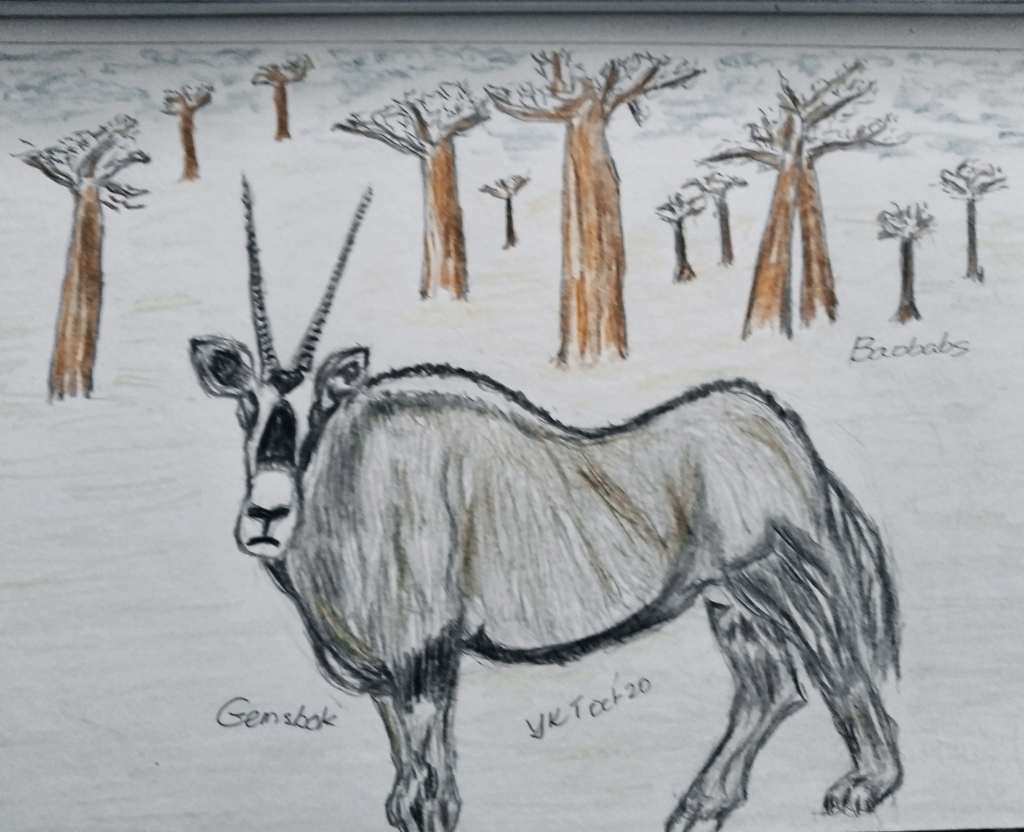
Today there’re about 1000 wild oryx due to a world-wide drip-drab effort to breed them in zoos and releasing them to the Arabian peninsula. 6000-7000 of them are in captivity overseas, ironically keeping them safe from poachers in the Middle East. One day the diaspora will return to its rightful home. Just like the restoration of threatened human races.
Babies are forever
Unlike most humans, wild animals breed unceremoniously. They needed to, as it is studied that they generally have shorter lifespans compared to captive ones. While infant mortality is high, infanticide to ensure the stronger brood survive occurs often. However the strong maternal instincts of wild animals are well observed – as a matter of necessity. Stories of inter-species motherhood are rife. Birds do adopt another species’ eggs, hatch and then raise a foreign chick. But some don’t such as the bald eagle.

Carly is a fan-tailed cuckoo, one of about 54 species of the cuculidae family. When spring comes around she might change her calling tune, reasons not clear. But that’s when she lays her eggs – up to 20 of them. How could one have a nest that big, and how much grub does it need? No problem – the cuckoo bird practices what is known as brood parasitism. She’ll go about to whatever nests she can find and deposit her eggs in somebody’s house, literally. Often she’ll succeed having a free upbringing for her brood, but sometimes they get rejected, such as from reed warblers. One of her eggs found its way to an eagle’s nest. Mother eagles are fiercely protective. So the day came for the cuckoo egg to hatch and the fledging crawled out of its tiny shell crying for food. The mother had been feeding the older, bigger (original) chick. When she returned to the nest with a lizard she stared at the yellow furry ball of new arrival. Of course baby opened her mouth wide and the befuddled mother would feed all opened mouths! So the baby overcame the greatest obstacle – getting its predator to feed it, even to love and protect. But the second more frightening prospect loomed ahead. Eaglets would eat as much as they can get, even the weaker fledging in the same nest. Then one day the bigger one became too impatient to wait for her grub that she started attacking the alien chick. In-situ lunch! But an angel arrived. In a flash out of nowhere the mother cuckoo flew on the bigger fledging. Carly must have been watching out-of-sight. With no time to spare before the eagle returns, Carly flew around the senior fledging to distract it from attacking, then just as swiftly, disappeared. Soon mother eagle returned none the wiser, with a skinny snake. This went on for some two weeks, with the shadow mother watching over her chick.

Soon it was graduation day for the brood. By din of luck the cuckoo survived without being food for the real fledglings – but although she was diminutive compared to her siblings, everyone behaved well. One by one the flight test started. But the cuckoo didn’t have to be pushed by mother eagle. She flew first class. And Carly? Maybe she was watching and maybe not. But some months later the eagle cuckoo was flying around the nest. It was looking strangely for food that a cuckoo would not be eating. Then it saw a small snake on the ground. Cuckoo now behaves like an eagle, eating eagle food other than insects and worms. Out of nowhere Carly descended on her long lost daughter. The young cuckoo was startled and angry, like asking “Who are you?” Carly started cooing softly, like a loving mother who’s found her own child. But the eagle cuckoo would have nothing of it. Instead it was as aggressive as an eagle about to attack a prey. Then Carly flew off. Her departing cry was a different tune. It was June. And her cry must also be a sad one.
Consider another orphaned beauty. Bibby was abandoned by his jaquar mother when a hunting party separated them in the Amazon jungle. Fortunately he was too small to make his coat valuable and was spared the bullet. Bibby was wandering by the riverside when he was spotted by animal lover Tracy who surveys the Brazilian forests for stray orphans. Tracy considered that was her luckiest day to take Bibby to the Reserve though that honor rightly belonged to the emaciated cub.

So when Bibby settled in he was alone and Tracy was wondering if she could introduce him to Shima, a baby cheetah who was an abandoned pet. Cheetahs are only endemic in Africa as Asiatic ones had long been extinct. A pet cheetah in Brazil is rare for the vulnerable species.
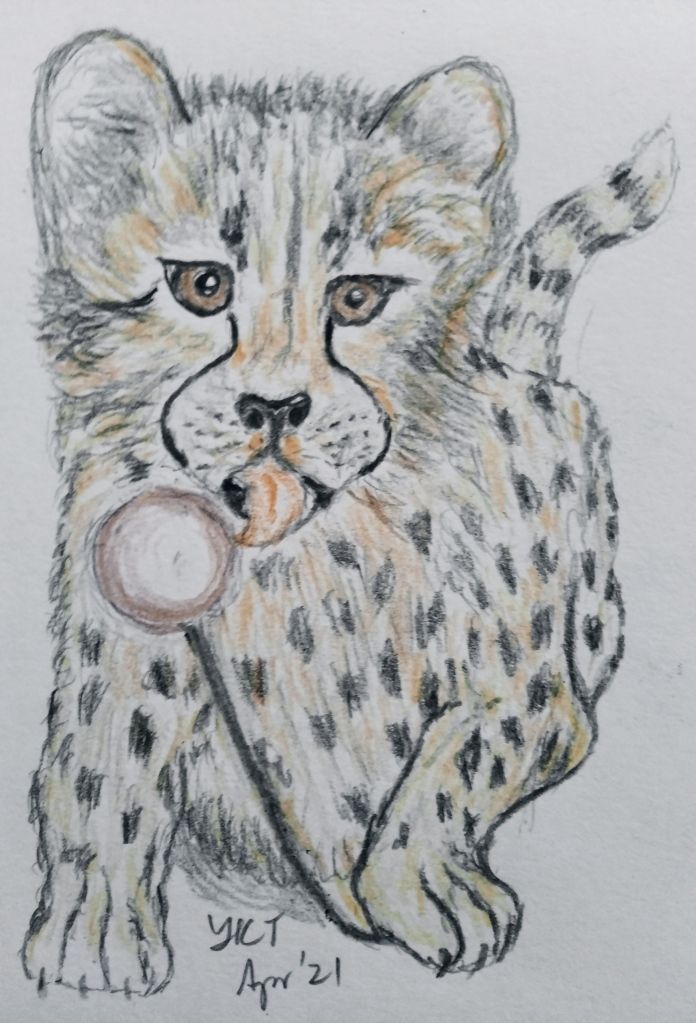
But Tracy didn’t have to worry – the two took to each other instantly, playing like chums. Bibby being the stronger would push Shima around, but he didn’t know her speed until they started growing. When they did, Tracy was concerned how they might have enough space to run and perhaps hunt. So once in a while she’ll bring them in her jeep to the edge of the jungle. Animals have instincts that can be surprising. Bibby decided that Shima can chase the prey and he’ll help bring it down with his strength. Although cheetahs hunt in the day while jaguars in the night, the pair had no problem in the jungle, as Bibby could see well in the darkness. They became a celebrated pair in the Reserve – until one day Tracy was perplexed by Shima slowing down. And gaining weight. A visit to the resident vet brought smiles. The ultrasound revealed 3 little babies inside her. The pair made news again. For Tracy, she would have to start over taking care of 3 hybrids. Parenting can indeed be crazy.
My beloved varmint
In 1974 Patty Hearst, a billionaire heiress was kidnapped by SLA extremists to advance their cause. As she remained a prisoner, her abductors became friendly and started brainwashing her of their cause. As time went by it became easier for her to befriend her tormentors and started listening to their beliefs. Turns out that she became an adherent of their cause and was finally released to become an member herself. The psychological response when hostages or abuse victims bond with their captors or abusers is called the Stockholm syndrome. This is an animal story of the same, in reverse syndrome, though not of the same depth.
The pest control industry amounts to $17.5 billion (2020) in US alone. Vermin would eat anything in the house worth chewing – from carpets and wedding suits to jewelry items. In the Chinese zodiac the year of the Rat brings a vitality of survival, with its ability to seek out food resources as well as fertility to conceive. But from young one is wont to see trapped vermin scalded by hot water or left to drown, poisoned or exterminated by any means to avoid the plague or something worse. Rats and mice are also depicted adorably with the dozen or so fables in children’s literature, let alone Mickey and Mighty Mouse.
So as a young boy Kenta used to cry every time his parents brought out a caged rat to be exterminated. His brother once even used an arrow to execute a large rat. Then as he grew up and had his own house he knew what to do with vermin that soil the kitchen table or nibble up the fruits on the basket. As he exterminated each one caught, the next killing became easier. Until one day he took a closer look. He had caught a large one and decided a less messy way was to drown it in a large bucket of rain water. After watching the rattling of the submerged cage in the bucket subsided he took it out to the garbage dump. But he didn’t wait long enough – the rat slowly revived and scampered drunkenly to the neighbor’s house. Kenta was fuming – cursing that it would soon find its way to his kitchen. Several weeks later he had to again set the trap. And drunken mousy was caught again. This time he made sure to wait twice as long before dumping the corpse out of the cage. But he made another mistake – he bend down to look at the dead rat. He could not forget the expression of the contorted face of the drown rat. Sleepless for several nights he swore never to kill another animal again.

That eased his conscience for several months – until more scats appeared at his kitchen and cooking top. Garbage were also littered around. Out came the cage again and once more Kenta had a prisoner. He was troubled. So he decided to leave the prisoner out in the yard for as long as possible. But he could not forget the face of a troubled animal. After a few hours he would walk out to the yard to check on his prisoner. Then sorrow turned to pity as the hungered rodent jumped around the cage in terror. How about some food? He thought for a moment. Well the Geneva Convention says you have to feed your prisoners… so after every meal he would take the scraps to his prisoner in the yard. Kenta felt better. For how long can a vermin be a pet? Then something interesting – each time he approached the cage Jake would seem pleased, expecting food. After a few days, Kenta decided the prisoner must be released. He turned to Jake and said – “Let’s make a deal – speak to me and I’ll let you go.” No reply. Still seeing the starving animal, Kenta opened the cage and Jake staggered out. “Now don’t ever you come back or you’ll not get the chance again!” Several weeks passed. No scats. Then one morning while cleaning up the kitchen he heard a squeak. Looking over the yard there was Jake – standing up on its hind legs, begging for food. From then on, Jake became Kenta’s backyard pet, turning up at every mealtime begging. Somehow Jake understood not to raid the kitchen and Kenta felt glad. But not for long.
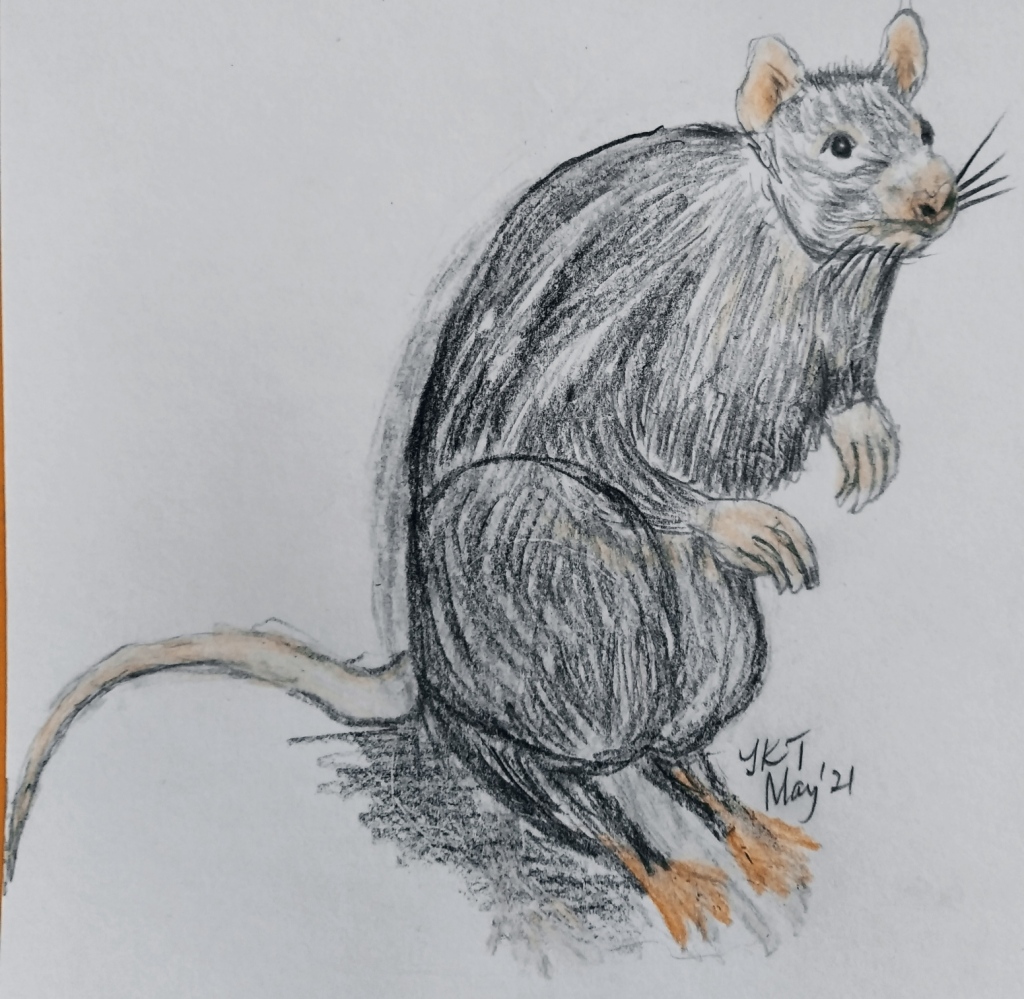
One morning when Jake stood up for his scraps Kenta noticed something – a bulging tummy! Jake was a Jill ! He almost cried. No – this cannot continue – rats produce up to two dozen off-springs a litter. With a heavy heart Kenta set the trap again, and Jill willingly got caught. That grey sky afternoon Kenta did it. To his pet. With a heart so heavy that he’ll never set his eyes on a rat face again. Perhaps a face of anger in betraying a friend.
The tree King
How do trees grow? It starts with a seed – already equipped to make its own food and it must have a location to receive water, nutrition from the soil, sunlight and carbon dioxide. The last four items are the ingredients for photosynthesis – the food making mechanism of all plants. But the mystery of all life is how cells form, eat, multiply and die, questions that still lie unanswered fully at the root of our existence. Plants and vegetation have an uncanny tenacity to survive and thrive and might even provide the answers to the life and death of human cells. Also a typical hardwood tree by photosynthesis absorbs 1 ton of CO2 in 40 years so 1 trillion trees grown today will end global warming then! There’s a parable from the bible (Judges 9:7-15) of trees talking to themselves on their usefulness. The tall, splendid trees of Lebanon started by complaining they had no ruler.

So they went to an olive tree asking it to be their king. The olive tree replied that it was already serving honorably by its fruit of abundance, and so how should kingship improve it. The Lebanon cedars then turned to the fig tree who gave the same answer regarding the sweetness of its figs. It would be useless if it left its fruits to be king.
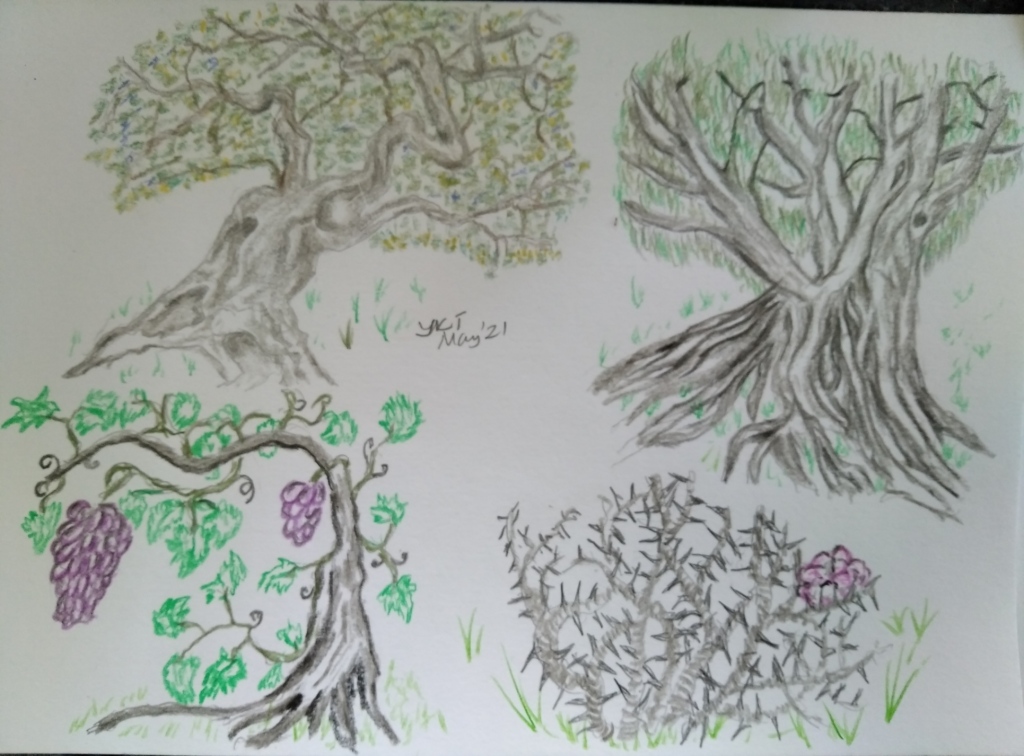
Disappointed, they then turn to the smallish grape tree to reign over the towering cedars. The grape tree was disturbed. “Wasn’t the sweetness of wine produced from my grapes good enough to cheer men and God and you ask me to be an administrator?” Discouraged, the lofty Lebanon trees finally turned to the lowly bramble bush and asked abashedly, “Come, come and reign over us, we need a king.” The thorn-bush’s reply to the Lebanon cedars was caustic. “You tall giants, talking to a lowly bush asking to be king. If you really mean what you said, all I can offer is the shade from my thorny branches to protect you from the blazing sun. But if you’re not asking me in good faith, then fire will come out of my thorns to consume all of you!”
Today as the entire earth faces the solar system heating up our planet without the cooling effect of the outer atmosphere, ironically referred by the bramble bush as the burning up from the sun who’s going to lead to solve our climate change problems?
Why the Spider jump
One in 54 US children have some form of autism in 2016. Autistic Spectrum Disorder (ASD) is caused by various factors including cerebral deficiency during growth. Genes and environment are contributing factors as it is suspected many more people suffered from a mild form of ASD undetected but managed to overcome it growing up. The world must have muddled through how to handle severe ASD cases before knowing about it today and many children suffered terrible mental and physical agony without any treatment. Even today treatment is mainly social and communicative intervention and therapy, with no definitive cure. Some of us might have suffered the secondary effects such as childhood bullying, parental neglect or abuse or just social malign, without realizing ASD as a contributory cause. What about animals? Are there neurological growth disorders with animals?
Spindly is a young spider. His parents must have conceived him and then left. Spindly had to fend for himself – just like many newborns in the animal world. So he wandered about, and hit a wall. There were small crawly ants around and he promptly caught his first meals. Then Spindly climbed further up the wall and before long hit the ledge of a window sill. He clambered over it into the open window.
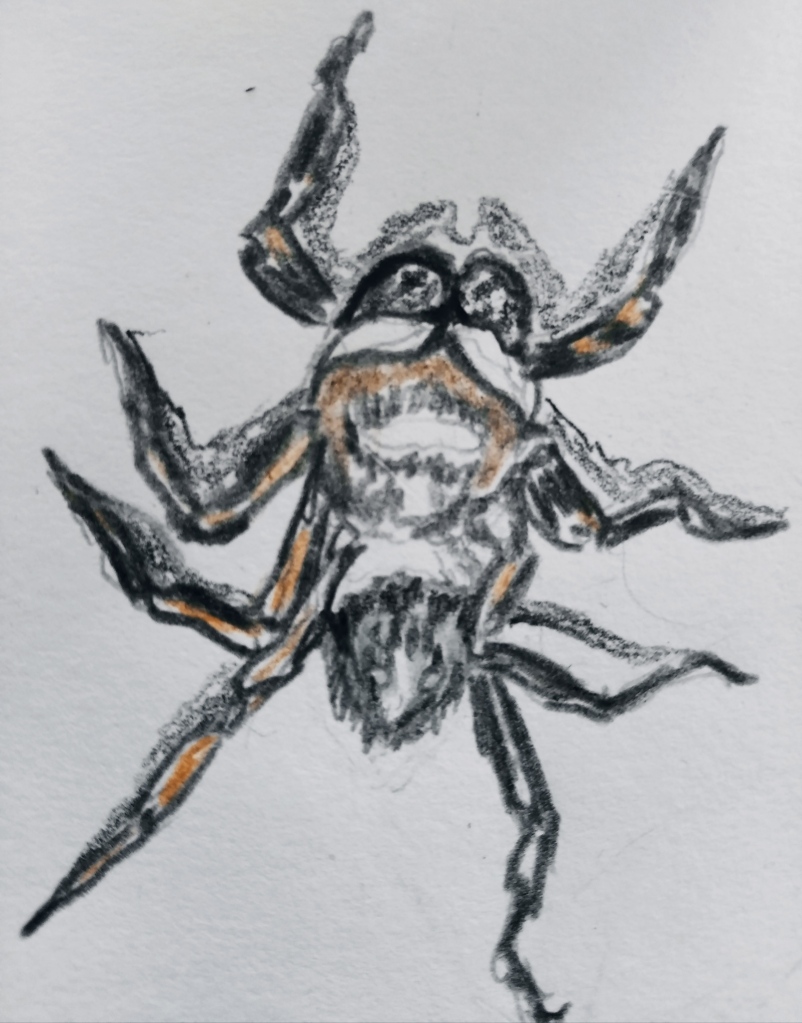
There was Mickey a severely autistic boy staring out the window, as usual. He looked down at the arachnid and was amused than fearful. Without saying a word, he quickly withdrew to the kitchen and returned with an empty matchbox. Slowly Mickey coaxed Spindly into the opened slit. Mickey doesn’t ask his mother questions how to feed Spindly, but having watched Nature television, he figured some dead ants and maybe bits of grass would do. So he kept Spindly as a pet without anybody in the household knowing. It was his private world – relationship with Spindly meant hours taking it out of the box and watching it move and crawl over his white exercise book. One day he was depressed and felt the urge to scream, as was his habit for a release. But when he opened Spindly’s box he noticed something dramatic. It crawled out, took a few steps then jumped. It was not a long jump, but a high one – straight up into the air and down. Then something clicked. Mickey started to jump too. He felt an immediate release from inside his head. Again and again he jumped, just like the spider and felt real joy. Indeed he started jumping all over the house, groaning in joy. His mother was enthralled – never had she seen Mickey enjoying himself in any sport or activity. Curious, she looked up the internet to figure out why autistic kids jump. And that was where she came to know of the book “The reason I jump”, by Naoki Higashida a 13-year old severely autistic boy who recorded his daily travails the inner voices of his mind as he battled speech apraxia. Since then her mother decided to get Mickey a trampoline and taking him out to jump on the gymnast pommel-horse. It became a therapy treatment for Mickey. What about Spindly?
One day Mickey’s sister happened to be in his room, looking to borrow a pencil-eraser from his drawing table. As she turned to go, something jumped in front of her on the table. Looking closely, she screamed. Mickey and her mother were out in the gym and had not told her about Spindly. She started to imagine large monstrous arachnids when the tiny Spindly starts to grow. She returned from the toilet cupboard with a spray. Spindly crumbled into a heap. That evening when Mickey found out he was inconsolable and shut himself in for hours. But her mother knew what to get him for his next birthday. An insect barely the size of a peanut, but became the joy of the unspoken world.

